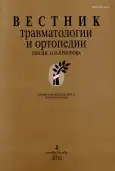Full -Function Restoration of Achilles Tendon with Nanofibrous Implant (experimental study)
- 作者: Senotov A.S1, Ol’khov A.A2, Sklyanchuk E.D3, Fadeeva I.S1, Fadeev R.S1, Fesenko N.I4, Prosvirin A.A3, Lekishvili M.V5,6, Gur’ev V.V3, Iordanskiy A.L7, Akatov V.S1
-
隶属关系:
- Institute of Theoretical and Experimental Biophysics
- Plekhanov Russian University of Economics
- Moscow State University of Medicine and Dentistry named after A.I. Evdokimov
- Pushchino State Institute of Natural Sciences
- N.N. Priorov Central Institute of Traumatology and Orthopaedics
- Institute of Applied Economic Research
- Semenov Institute of Chemical Physics
- 期: 卷 23, 编号 4 (2016)
- 页面: 50-54
- 栏目: Original study articles
- URL: https://journals.rcsi.science/0869-8678/article/view/47288
- DOI: https://doi.org/10.17816/vto201623450-54
- ID: 47288
如何引用文章
全文:
详细
作者简介
A. Senotov
Institute of Theoretical and Experimental Biophysicsнауч. сотр. лаборатории фармакологической регуляции клеточной резистентности ИТЭБ РАН Pushchino, Russia
A. Ol’khov
Plekhanov Russian University of Economicsканд. техн. наук, старший науч. сотр. лаборатории перспективных материалов и технологий РЭУ им. Г.В. Плеханова, старший науч. сотр. лаборатории диффузионных явлений в полимерных системах ИХФ им. Н.Н. Семенова Moscow, Russia
E. Sklyanchuk
Moscow State University of Medicine and Dentistry named after A.I. Evdokimovдоктор мед. наук, профессор каф. травматологии, ортопедии и военно-полевой хирургии МГМСУ им. А.И. Евдокимова, зав. ортопедическим отделением Дорожной клинической больницы им. Н.А. Семашко на станции Люблино ОАО «РЖД» Moscow, Russia
I. Fadeeva
Institute of Theoretical and Experimental Biophysicsканд. биол. наук, старший науч. сотр. лаборатории тканевой инженерии ИТЭБ РАН Pushchino, Russia
R. Fadeev
Institute of Theoretical and Experimental Biophysicsканд. биол. наук, старший науч. сотр. лаборатории фармакологической регуляции клеточной резистентности ИТЭБ РАН Pushchino, Russia
N. Fesenko
Pushchino State Institute of Natural Sciencesканд. биол. наук, доцент Учебного центра биофизики и биомедицины ПущГЕНИ Pushchino, Russia
A. Prosvirin
Moscow State University of Medicine and Dentistry named after A.I. Evdokimovассистент кафедры травматологии, ортопедии и военно-полевой хирургии МГМСУ им. А.И. Евдокимова Moscow, Russia
M. Lekishvili
N.N. Priorov Central Institute of Traumatology and Orthopaedics; Institute of Applied Economic Researchдоктор мед. наук, зав. лабораторией «Тканевой банк» ЦИТО им. Н.Н. Приорова Moscow, Russia
V. Gur’ev
Moscow State University of Medicine and Dentistry named after A.I. Evdokimovдоктор мед. наук, профессор каф. травматологии, ортопедии и военно-полевой хирургии МГМСУ им. А.И. Евдокимова, рук. Центра травматологии и ортопедии Дорожной клинической больницы им. Н.А. Семашко на станции Люблино ОАО «РЖД» Moscow, Russia
A. Iordanskiy
Semenov Institute of Chemical Physicsдоктор хим. наук, профессор, зав. лабораторией диффузионных явлений в полимерных системах ИХФ им. Н.Н. Семенова Moscow, Russia
V. Akatov
Institute of Theoretical and Experimental Biophysics
Email: akatov.vladimir@gmail.com
доктор физ.-мат. наук, профессор, зав. лабораторией тканевой инженерии ИТЭБ РАН; Тел.: 8 (496) 773-49-52 Pushchino, Russia
参考
- Meier Bürgisser G., Buschmann J. History and performance of implant materials applied as peritendinous antiadhesives. J. Biomed. Mater. Res B Appl. Biomater. 2015; 103 (1): 212-8.
- Doroski D.M., Brink K.S., Temenoff J.S. Techniques for biological characterization of tissue-engineered tendon and ligament. Biomaterials. 2007; 28 (2): 187-202.
- Cooper J.A., Lu H.H., Ko F.K., Freeman J.W., Laurencin C.T. Fiber-based tissue-engineered scaffold for ligament replacement: design considerations and in vitro evaluation. Biomaterials. 2005; 26 (13): 1523-32.
- Jaibaji M. Advances in the biology of zone II flexor tendon healing and adhesion formation. Ann. Plast. Surg. 2000; 45: 83-92.
- Склянчук Е.Д., Ольхов А.А., Акатов В.С., Гурьев В.В., Иорданский А.Л., Филатов Ю.Н. и др. Способ повышения регенерационного потенциала имплантатов для восстановительной хирургии соединительной ткани. Патент на изобретение РФ №2561830 от 10.09.2015 г.
- Ольхов А.А., Склянчук Е.Д., Аббасов Т.А., Акатов В.С., Фадеева И.С., Фадеев Р.С. и др. Регенерационный потенциал нановолоконного сухожильного имплантата из полигидроксибутирата. Технологии живых систем. 2015; 12 (2): 3-11.
- Ольхов А.А., Староверова О.В., Гурьев В.В., Аббасов Т.А., Орлов Н.А., Ищенко А.А. и др. Матриксы для тканевой инженерии на основе модифицированных нановолокон поли-(3-гидроксибутирата), полученных методом электроформования. Физика волокнистых материалов: структура, свойства, наукоемкие технологии и материалы (SMARTEX). 2016; 1 (1): 57-68.
- Жаркова И.И., Староверова О.В., Воинова В.В., Андреева Н.В., Шушкевич А.М., Склянчук Е.Д. и др. Биосовместимость матриксов для тканевой инженерии из поли-3-оксибутирата и его композитов, полученных методом электроформования. Биомедицинская химия. 2014; 60 (5): 553-60.
- Корнилов Д.Н., Попов И.В., Раевская Л.Ю., Гольдберг О.А., Лепехова С.А. Реконструктивная операция на ахилловом сухожилии крысы: Этапы оперативного вмешательства, топографо-анатомическое обоснование. Сибирский медицинский журнал. 2014; 125 (2): 35-8.
- ГОСТ ISO 10993-1-2011 «Изделия медицинские. Оценка биологического действия медицинских изделий. Часть 1. Оценка и исследование».
- ГОСТ ISO 10993-6-2011 «Изделия медицинские. Оценка биологического действия медицинских изделий. Часть 6. Исследования местного действия после имплантации».
补充文件






